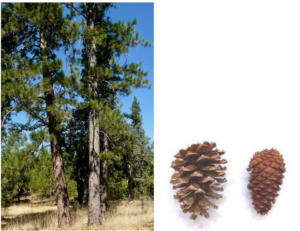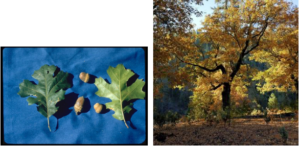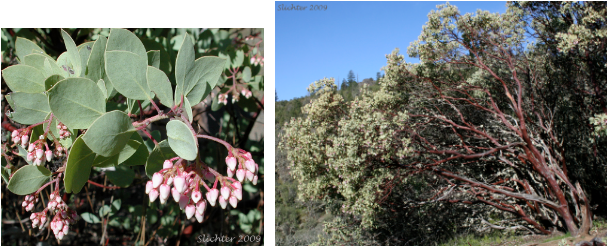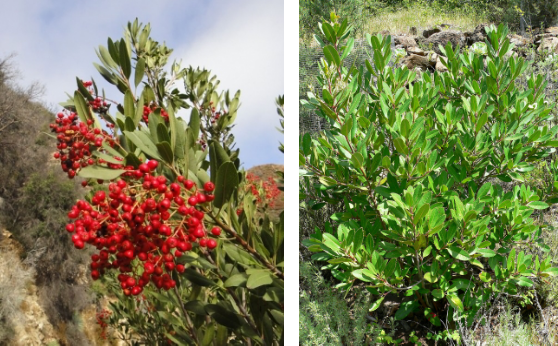Can you name any of the trees and shrubs around you?
¿Puedes nombrar alguno de los árboles y arbustos que te rodean?

The ponderosa pine (Pinus ponderosa) is one of our most common pines around here and has 3 needles generally wrapped in little bundles, and the cones have big prickles on the tips of their scales – we call them prickly ponderosas. When ponderosas mature their bark forms big reddish-brown, square plates.
El pino ponderosa (Pinus ponderosa) es uno de los pinos más comunes por acá y tiene agujas en ramos de tres, generalmente envueltas en pequeños paquetes. Los conos tienen grandes espinas en las puntas de sus escamas y, por eso, las llamamos pinos ponderosas espinosos. Cuando los pinos ponderosas maduran, su corteza forma grandes placas cuadradas de color marrón rojizo.

Black oaks (Quercus kelloggii) are one of many oaks that live in the foothills but it is the favored oak of the Nisenan and other tribes because its acorns are big and the sweetest of all the oaks. The black oak has dark bark and has lobed deciduous leaves with spiny tips on each lobe. The leaves turn a beautiful gold in the fall. Deer, squirrels, jays, woodpeckers and other mammals depend on the acorns and many other species use different parts of the tree for food and or shelter. There are several large black oaks along this trail. Can you spot them? Oak woodlands are a rich and valuable habitat wherever they occur.
Encinas Negro (Quercus kelloggii) son uno de los muchos robles que viven en las colinas, pero es el roble favorito de los Nisenan y otras tribus porque sus bellotas son grandes y las más dulces de todos los robles. La encina tiene la corteza oscura y tiene hojas caducas lobuladas con puntas espinosas en cada lóbulo. Las hojas se vuelven de un hermoso color dorado en otoño. Venados, ardillas, arrendajos, pájaros carpinteros y otros mamíferos dependen de las bellotas y muchas otras especies usan diferentes partes del árbol como alimento o refugio. Hay varias encinas grandes a lo largo de este sendero. ¿Puedes detectarlas? Los bosques de robles son un hábitat rico y valioso dondequiera que se encuentren.

Manzanita (Arctostaphylos viscida) is the shrub with the red-brown bark and oval blue-green leaves. This shrub gets a bad rap because it is flammable but it is also a very important food source for birds and mammals. Native Americans make a refreshing drink from mashing the sweet berries and pouring water over them. There are over 30 different species of manzanita around the state and one of them, bearberry, grows around the world!
Manzanita (Arctostaphylos viscida) es el arbusto con la corteza de color marrón rojizo y hojas ovaladas de color verde azulado. Este arbusto tiene mala reputación porque es inflamable, pero también es una fuente de alimento muy importante para aves y mamíferos. La gente indígena de esta área hace una bebida refrescante triturando las bayas dulces y echando agua sobre ellas. ¡Hay más de 30 especies diferentes de manzanita en todo el estado de California y una de ellas, la gayuba, crece en todas partes del mundo!

Toyon or Christmas Berry (Heteromeles arbutifolia) is the shrub whose leaves have little saw-tooth edges, white flowers in June, and beautiful red berries in the fall. The fruits are also very important food sources for birds and mammals.
Toyón (Heteromeles arbutifolia) es el arbusto cuyas hojas tienen pequeños bordes de dientes de sierra, flores blancas en junio y hermosas bayas rojas en otoño. Los frutos también son fuentes de alimento muy importantes para aves y mamíferos.
